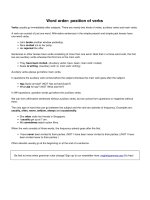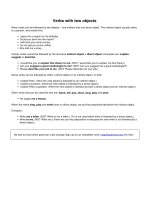Two word verbs
Bạn đang xem bản rút gọn của tài liệu. Xem và tải ngay bản đầy đủ của tài liệu tại đây (10.67 KB, 1 trang )
Two-word verbs
Many English verbs can be followed by prepositions or adverb particles.
Do sit down.
Alice ran down the road without looking at anybody.
Some verbs and prepositions / particles are regularly used together. Examples are: look at, listen to, stand up and
switch off. These combinations are rather like two-word verbs. In grammars these are often called phrasal verbs.
The meaning of a two-word verb can be very different from the meanings of the two-parts taken separately.
The meeting had to be put off. (The meaning of put off is not the same as the meanings of put and off.)
Some verbs can be used with both an adverb particle and a preposition.
Examples are: get on with, put up with and look out for.
The two parts of a phrasal verb made with a verb + adverb particle are often separable. That means the particle
can go before or after noun objects.
Can you switch off the light? OR Can you switch the light off?
Note that adverb particles can only go after pronoun objects.
She turned it off. (NOT She turned off it.)
The preposition in a verb + preposition combination usually goes with the verb. It can’t be separated from the
verb.
He fell off the ladder. (NOT He fell the ladder off.)
Stay on top of your writing! Download our grammar guide from www.englishgrammar.org to stay up-to-date.
Powered by TCPDF (www.tcpdf.org)









